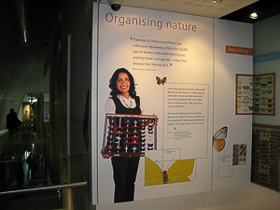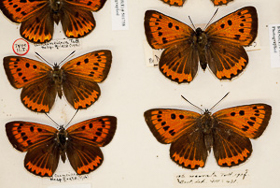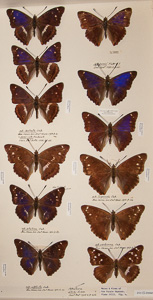 |
| Geoff Martin with Piers Vigus Image © Peter Eeles |
Pete:
Geoff - many thanks for agreeing to be interviewed. So how did you first get interested in Lepidoptera?
Geoff:
I was a 10-year old boy in the hot summer of 1976 when populations of many insect species rocketed (although they crashed a year later). We were doing a project at school on metamorphosis and I began to read the book The Young Specialist Looks at Butterflies and Moths by Georg Warnecke. This introduced me to a variety of topics, including collecting, and my interest grew from there - there were no Playstations in those days, and only 3 channels on TV!
I eventually left school and followed a completely different career path to the one I have now. At the age of 26 I took a degree in Ecology. After graduating I sent my CV to the Natural History Museum, thinking I didn't stand any chance of getting a job, but got an interview within a couple of days which resulted in a short-term contract. Following that, I spent a little time at the London Wetlands Centre, planting trees around the reservoir, but eventually returned to the museum as an employee, taking up the post of Lepidoptera Curator, which had been vacated by Mark Parsons who now works for Butterfly Conservation.
Piers:
So what sort of work did you do on your short-term contracts?
Geoff:
Initially I was looking at some of the library references for the Geometridae Catalogue of the World. An area of focus for the museum is taxonomy and making catalogues of world species - so that species names are consistent across different scientific disciplines. As you can imagine, with the scientific names of British butterflies, there might be a dozen names, minimum, for each species. So you can appreciate that a lot of work was involved in the production of checklists and catalogues for the Geometridae - 25,000 species in total. Someone had to go to the museum library and check the references for every single species!
Piers:
On the subject of taxonomy, what do you make of the current fashion for "splitting" species?
Geoff:
It depends on the species. Some species definitely need splitting into two (or more) separate species and others definitely need lumping together!
Pete:
How do you work with other organisations that are also performing taxonomic research?
Geoff:
Our researchers here collaborate with other researchers worldwide. We have researchers visit us from institutes all over the world to consult the collections every year. We also loan specimens out to them, as well as image specimens on their behalf. Although taxonomy is a major focus of the museum, there is also research on biodiversity decline, disease, climate change and environmental pollution.
Piers:
Given the focus on taxonomy, do you think there will be an update to "Bradley and Fletcher" that is used by many enthusiasts in Britain looking for a single taxonomic reference, given that the last edition was produced in 2000?
Geoff:
Possibly - but this is probably something that would not be produced by the museum.
Pete:
As Lepidoptera Collections Manager, what does your day-to-day work actually involve?
Geoff:
In simple terms, I look after the collection and we have 6 curators in total. We have 80,000 drawers of just butterflies and moths! Around 5,500 drawers house the British specimens. Each curator has various groups of families that they work on.
We also reorganise the collection and move specimens to new storage when required. As I said earlier, we deal with a lot of scientific visitors. We send out loans of specimens and also image many of our specimens, since many researchers are happy with an image (rather than a specimen) for their work. Of course, this approach is much preferred since specimens don't get lost or damaged in transit.
Pete:
Since the collection has been built up by consolidating individual collections, was there a "core collection" that formed the basis at the start?
Geoff:
The collection of Hans Sloane, a notable London physician and collector, really forms the basis of the natural history collection in the museum. Sloane's will stipulated that the collection should remain together, preferably somewhere within the city of London. He offered the collection to the Crown for the sum of £20,000, payable to his two surviving daughters. The Crown approved the purchase on 7 June 1753. Many collections have been added over time, though. For example, the museum contains the collection of Joseph Banks, the ship's naturalist on Captain Cook's expeditions as well as one of our more-famous collections, that of Darwin himself.
 |
| Darwin's statue is now prominently positioned in the museum Image © Peter Eeles |
The museum also houses many of the "type specimens" that were used to first identify and represent various species, and on which the original description of that species is based. There are 125,000 type specimens of Lepidoptera in the museum - which is roughly 50% of the world "types". However, these aren't always representative of unique species since very variable species are often "identified" more than once.
Piers:
Is there a particular collection that forms the basis of the British Lepidoptera collection?
Geoff:
The Rothschild Cockayne Kettlewell collection, also known as the "RCK" collection, was formed in 1947 through the amalgamation of several extensive collections.
Pete:
Given that this is a "world collection", how is it organised and catalogued?
Geoff:
The British collection is ordered by the Bradley and Fletcher checklist. The rest is organised by the latest world checklist or catalogue. The primary purpose of organising the collection is to help people find the specimens they're after.
Piers:
Are you still acquiring type specimens, even of European species, for example?
Geoff:
There are thousands of species that have yet to be described - in fact, we have between 20,000 and 30,000 drawers of specimens (out of the 80,000) that have yet to be sorted.
Pete:
We've already described some uses of the collection, but what else might it be used for?
Geoff:
Aside from taxonomists and researchers, a collection may have been created from a particular area (such as Ecuador) and a researcher needs a comprehensive resource that they can use to identify the individual specimens. This information can then be used for conservation purposes once the species that occur in that area have been identified.
We also get visitors wanting to look at historical specimens so that they can study changes in phenology due to climate change, for example. They can use the information on data labels so that emergence dates can be compared. This is a new use of the collection that, 15 years ago, wouldn't have been thought of. All of the data associated with each specimen provides a fantastic repository.
With taxonomic systematics, DNA also now plays a major part - previously morphology was used as the basis of identification. You can get DNA even out of old specimens. We're currently involved in a project to "bar code" the DNA all of the British Lepidoptera.
Piers:
Presumably, the DNA barcoding could also be used to help with the "lumping" and "splitting" of species?
Geoff:
Absolutely. The specimens in the collections are frequently used for DNA barcoding. Some species are now very hard to collect due the political situation in their host country and species that occur across many countries would be very expensive to collect samples from.
Pete:
What were the primary reasons for the new facilities in which the collection is now stored?
Geoff:
Pests, climate and light! At its most fundamental level, the environmental conditions that our Entomology collections were held in previously put the collections at risk. Dried collections are always under threat from carpet beetles and we needed new collections spaces that would protect them. High humidity can also cause specimens to go mouldy. The final challenge is light, which can cause specimens to fade over time.
We now have cabinets that, while made out of metal and less aestethically-pleasing than wooden cabinets, have a pest-proof seal. Once the door is closed, nothing can get in or out! There is also climate control in the building. The lights in the new facility also go out every 20 minutes. Incredible as it may sound, we have specimens in really good condition dating back to the late 1700s; over 300 years old!
 |
| State of the art cabinets now house the national collection Image © Peter Eeles |
Pete:
If a member of the public wanted to see the collection, how would they go about it?
Geoff:
We now have the Angela Marmont centre for UK Biodiversity that opened earlier this year - that contains a synoptic collection of British Lepidoptera and is there for the public to view. This is separate to the main collection which is usually too extensive for anyone to take in at once! Anyone can make an appointment to see this. Each species is represented by a pair of specimens, along with any common forms. So the Comma, for example, also has the hutchinsoni form represented.
The new Darwin Centre is really quite impressive and an awe-inspiring new public space that allows visitors to explore the natural world in an exciting and innovative way. The architectural piéce de résistance is a 65 metre long, eight-story high cocoon - the largest sprayed concrete, curved structure in Europe - which safeguards 17 million insect and 3 million plant specimens. Visitors can journey into and around the cocoon to see how museum scientists work as well as offering a peek into the collections and laboratories.
 |  |
| Blanca Huertas, butterfly curator - one of the many informative displays in the Darwin Centre Image © Peter Eeles | Stunning images are on display in the Darwin centre Image © Peter Eeles |
 |
| Orange-tip specimens, including a bilateral gynandromorph, on general display in the Darwin Centre Image © Peter Eeles |
Pete:
I know you occasionally go on trips abroad as part of your work at the museum?
Geoff:
Yes - we often visit under-researched areas or areas where the collection is under-represented. The collection is continually evolving and made available to researchers all over the world. Also, occasionally, unidentified specimens will be made available to a researcher and come back identified! It's a working reference collection.
Pete:
Do you encourage volunteers and what would they help with?
Geoff:
There is a volunteer programme where individuals can express an interest in what they'd like to do. We have 5 or 6 volunteers that help with Lepidoptera. They range from retirees to college students.
Pete:
What's the rarest specimen in the Lepidoptera collection?
Geoff:
Anything that is now extinct is, by definition, rare. We also have plenty of species where we have one specimen - and this isn't because it's necessarily rare, we just haven't found another specimen since! Again, some of the aberrations of British butterflies of very rare, bordering on unique!
 |
| Female specimens of the extinct British Large Copper Image © Peter Eeles |
Pete:
Do you have a favourite specimen?
Geoff:
The Carpenter moths from northern Australia are a favourite - absolutely enormous - the body is the same size as a small mouse. The larva of one of the species in this family is the witchetty grub.
Pete:
And a favourite butterfly or moth?
Geoff:
I like them all. But as far as British butterflies go, I don't think you can beat the Purple Emperor.
 |
| Purple Emperor aberrations Image © Peter Eeles |
Pete:
Many thanks for enlightening us regarding the work of the museum!
Geoff:
My pleasure.